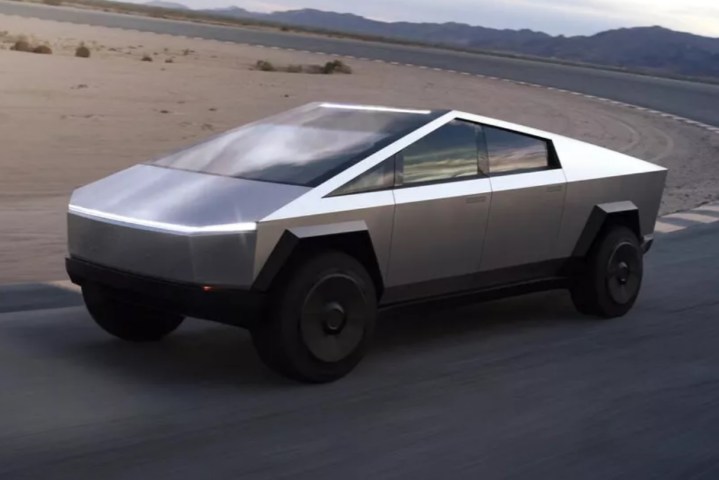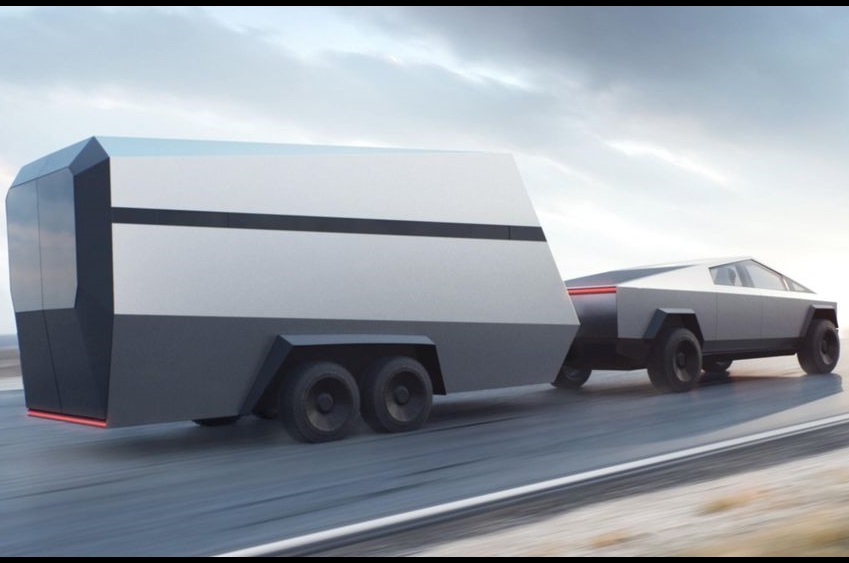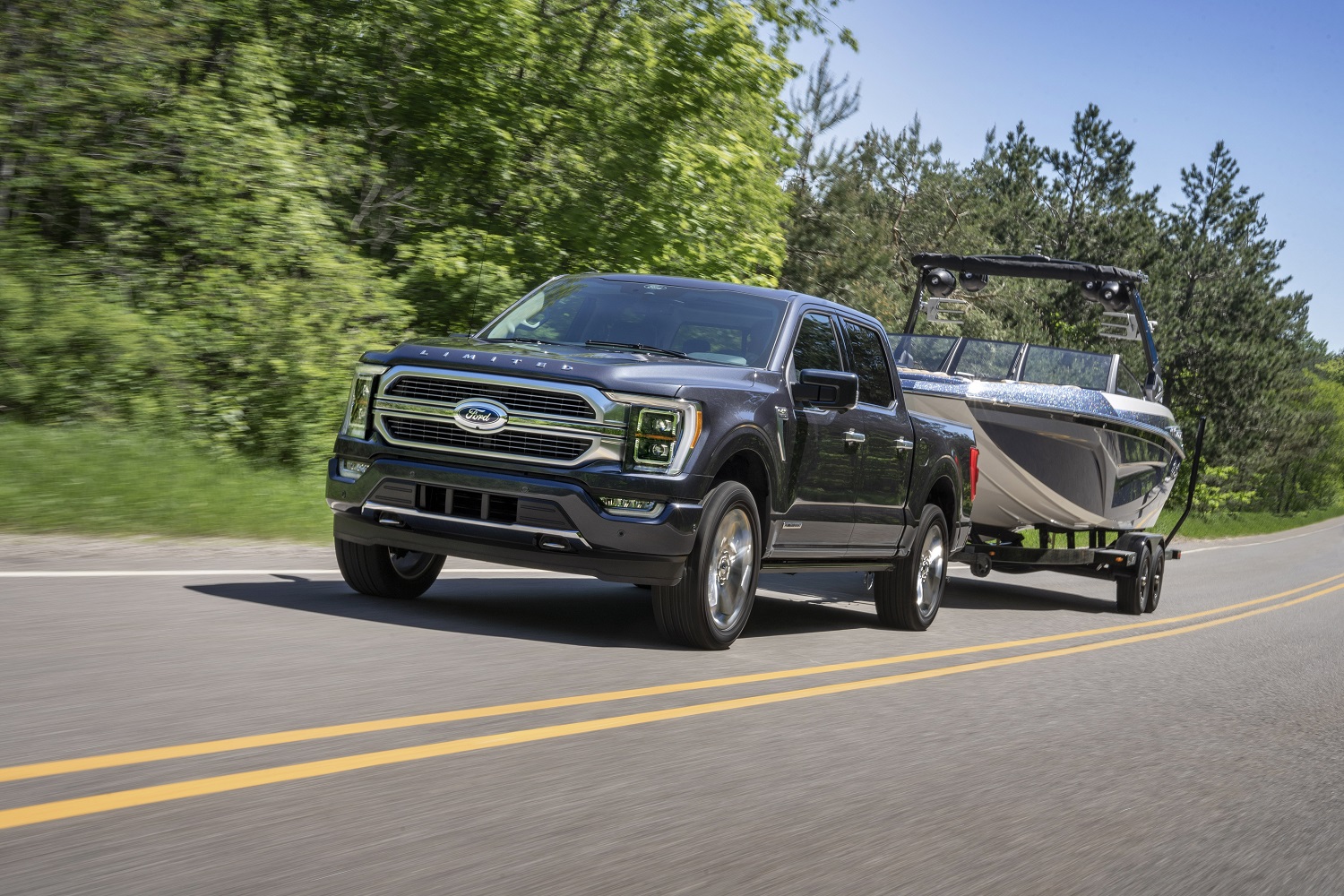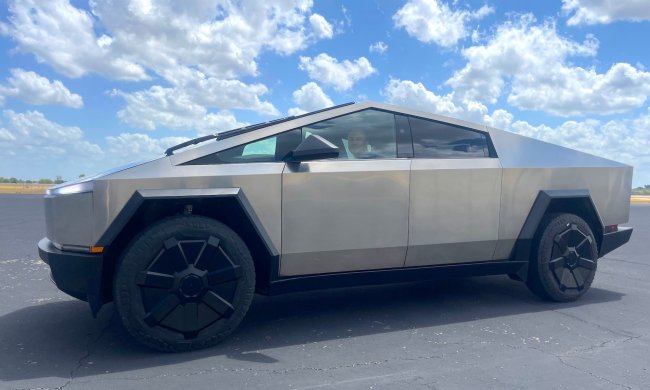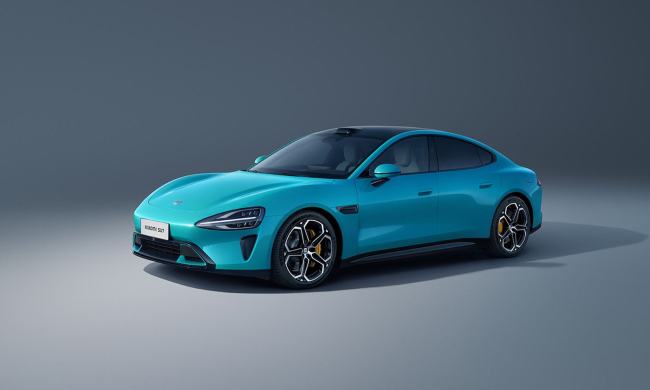Tesla strongly hinted the Cybertruck won’t compete in the same segment of the market as the popular Ford F-150, and whether they’ll appeal to the same target audience remains to be seen, but the two pickups will inevitably overlap in many areas. Both were designed to tow, haul, venture off the beaten path, and commute.
Keep in mind Tesla won’t begin building the Cybertruck until 2021 at the earliest. You can’t walk to the nearest Tesla store and take one for a test drive because it’s not in production; we haven’t even seen the production version of it yet. The comparison with the F-150 is largely hypothetical, and all specs listed here are subject to change.
Design and tech
Shaped like something the ancient Egyptians would build to bury their pharaohs in, the Cybertruck breaks all ties with Tesla’s current design language, and it looks like nothing else on the road. Whether you love it or you hate it, it’s certainly a truck you can’t ignore. It was unveiled with four doors, and it doesn’t sound like Tesla will offer other cab configurations (like one with two doors, or with rear-hinged half doors). Its cargo compartment — which is referred to as “the vault” — is 6.5 feet long and topped by a tonneau cover strong enough for an adult to stand on.
It’s a little bit closer to Tesla’s current cars when you step inside. The cabin has room for six passengers spread out over two rows, and the dashboard is entirely button-free thanks to a 17-inch, television-like infotainment system that reminds us of the Model 3’s. The Cybertruck will also offer many of the tech we’re familiar with, like the Autopilot suite of partially automated electronic driving aids. Video streaming and in-car gaming will be available, too.
New from the ground up for the 2021 model year, Ford’s hot-selling F-150 is available in three basic configurations called Regular Cab, SuperCab, and SuperCrew. The first two are available with either a 6.5- or an 8.0-foot cargo box, while the last one gains a third, 5.5-foot option. Inside and out, its design depends largely on the trim level selected. It’s a truck that needs to be everything to everyone, so it can be configured as a bare-bones workhorse with steel wheels, unpainted bumpers, and cloth upholstery, as an upmarket country-crosser that rivals German luxury cars in opulence, or anything in between. The raucous Raptor model will return in the coming months to put a unique spin on the muscle car with a model-specific front end, flared fenders, a desert-taming suspension, and an immensely powerful engine. While this sounds cliché, there is truly a truck for every need and budget.
How much technology Ford packs into the cabin again depends on the trim level selected. Fully loaded, the F-150 comes with adaptive cruise control, pedestrian detection, touchscreen-based navigation, parking sensors, a 360-degree camera, and dynamic hitch assist, which uses the rear-view camera to help the driver line up a hitch to a trailer. The next model due out in 2020 will gain even more tech features, including an on-board generator.
Will either fit in your garage? You tell us. The Cybertruck measures 231.7 inches long, 79.8 inches wide, and 75 inches tall. The F-150 is offered in several body styles, so its footprint varies from model to model. It measures between 209 and 250 inches long, 80 inches wide, and between 75 and 77 inches tall.
Specifications and performance
Tesla will offer three variants of the truck, though it hasn’t fully detailed them yet. Specifications are fabulously vague. The most potent Cybertruck hits 60 mph from a stop in 2.9 seconds, which is truly insane, and it runs the quarter-mile in 11 seconds. Those are figures we normally associate with supercars. These top-spec models will come with three electric motors, which sounds a lot like the high-performance Plaid drivetrain coming to the Model S.
F-150 buyers have a wide selection of engines to choose from, including the truck’s first gasoline-electric hybrid powertrain. The range includes a 290-hp V6, a 325-hp EcoBoost V6, a naturally-aspirated 5.0-liter V8 rated at 400hp, and a 3.0-liter turbodiesel V6 with 250 hp and a stout 440 lb.-ft. of torque. Finally, the 430-hp hybrid system is built around a twin-turbocharged 3.5-liter V6. An electric model will join the range later in the production run.
The only transmission available is a 10-speed automatic, but drivetrain options include rear- or four-wheel drive and either a standard- or an extended-range fuel tank. Note not every configuration is available with every body style.
Range and towing
The Cybertruck’s maximum driving range checks in at 250 miles for the entry-level, rear-wheel-drive model equipped with one electric motor, 300 miles for the mid-range version with dual-motor all-wheel drive, and up to 500 miles for the top-spec trim with three motors. Owners will be able to pay to use Tesla’s growing network of Supercharger stations or top up the battery pack (which will most likely be huge) at home.
Tesla pegged the Cybertruck’s towing capacity between 7,500 and 14,000 pounds depending on configuration, meaning it will likely qualify as a Class 2B-3 medium-duty truck. Trucks that fall into the Class 2B category have a gross vehicle weight rating (a vehicle’s maximum operating weight) of between 8,501 and 10,000 pounds. That’s a level above the F-150, which is a Class 2A model; it’s where you’ll find bigger models like the F-Series Super Duty (which can tow up to 37,000 pounds), the Ram 2500, and the Chevrolet Silverado 2500 twins. This is why the various videos showing the Cybertruck winning a tug-of-war with an F-150 are inaccurate and largely irrelevant.
There’s one advantage Tesla has over Ford: The Cybertruck’s body resists getting hit by a sledgehammer, and it withstands some bullets. Not all, mind you, so ask who’s shooting what before you drive into a war zone.
Fuel economy figures for the new F-150 haven’t been released yet. For context, the last-generation model’s combined fuel economy ranges from 16 mpg for a four-wheel-drive F-150 Raptor, to 25 mpg for a rear-wheel drive, turbodiesel-powered model, according to the Environmental Protection Agency (EPA). That’s not bad for a body-on-frame truck. Put another way, the F-150 offers road-trippers a maximum driving range of 900 miles, and 368 miles of range in its least efficient configuration. We know the new truck can haul up to 2,900 pounds and tow up to 14,000 pounds.
Pricing and availability
Tesla expects to begin building the Cybertruck in a new facility located near Austin, Texas, in late 2021, though it has a long history of not meeting deadlines. Pricing starts at $39,000, which puts the model in the same ballpark as mid-range versions of its gasoline- and diesel-powered rivals. The next model up costs $49,000, and the top-of-the-range model with the triple-motor powertrain carries a base price of $69,000. Buyers will not be able to claim a federal tax credit because the incentives allocated to Tesla expired on December 31, 2019. Those who want an early build slot can send the company a refundable $100 deposit. They’ll be asked to confirm their order and configure their truck in the weeks leading up to the start of production.
The F-150 is permanently stitched into America’s canvas. Available right away, the entry-level XL model carries a base price of $28,940, though it’s more of a construction site-spec work truck you’d rent from Home Depot than a comfortable cruiser you’d enjoy driving daily. The lavishly appointed range-topping Limited starts at $70,825.
Who else is in the game?

Although car companies love talking about electric pickup trucks, there is not a single one you can buy new in 2020. All of the models we’ve seen or heard about will arrive during the early 2020s. As of writing, alternatives to the Ford F-150 included the Ram 1500, which is available with a mild hybrid system, and the Chevrolet Silverado/GMC Sierra twins. The Toyota Tundra and the Nissan Titan are also worth a look, but loyalty runs stronger among truck buyers than in any other segment.
If everything goes according to plan, the category will balloon during the early 2020s. The Cybertruck’s closest rival is the outdoorsy Rivian R1T (pictured above), which was introduced at the 2018 edition of the Los Angeles Auto Show. It was scheduled to enter production in 2020, but it has been delayed until 2021. Buyers looking for a more heavy-duty rig can look at the Tonka truck-like Bollinger B2. It has a 7,500-pound towing capacity, and it’s brimming with clever features (like an end-to-end pass-through), but it starts at $125,000 — yikes. Alternatively, Lordstown Motor Corporation — a start-up few have heard of before — has started taking orders for its electric truck.
GMC resurrected the Hummer nameplate to put it on an electric pickup, but pricing starts at $112,595.
